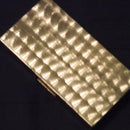Introduction: Bowie Knife
My goal in making this Bowie Knife was to use metal from my scrap pile to make the blade and make the handles (scales) from a dead Black Walnut tree on my acreage.
There are a lot of different metals that can be used in a lot of different ways to make a knife. That being said, I have quiet a few nice tools, but do not have a forge, so I proceeder with a piece of metal I could form with the tools I have, such as numerous hand and bench grinders, oxygen acetylene torch, hydraulic press, etc. The car spring leaf I picked was rusted with a few pits, but I wanted it to look old, not new, so that didn't bother me. In fact it adds character.
Step 1: Cutting the Car Spring
I cut the main leaf to 13.5" with an electric chop saw and made preliminary cut on tip of blade. I made 2 more cuts on the other end forming the tang for the bolster and scales.
Step 2: Roughing Out the Blade
Since i just had a mental picture of what it ought to look like, I started shaping & smoothing it with a 4" belt sander using a 40 grit belt. The tip turned up a little too much, so in the 5th photo, I blacked out what I wanted to remove. The 6th shows that part ground off.
Step 3: Making Revisions & Cutting Wood for Handles
I liked the straighter tip, so I then ground the rear of the blade to narrow it back toward the handle. My Grandson and I cut down the dead Black Walnut tree, which was about 7' diameter. We sawed it into a rectangular block and then sliced it into 2 scales, 3/8" thick. The lines you see on them in the photo are burn marks from the saw blade. Black Walnut is a pretty hard wood, but not nearly as hard as seasoned Bois D'Arc. I had some Bois D'Arc (pronounced "bo' dark", but AKA "Osage Orange", and "Hedge Apple"), but it is so dense it cannot be stained. (See my other instructable "Walking Canes") It can be "carbonized", by burning it with an oxy/acty torch and polished with a buffer wheel, but that was not the look I wanted
Step 4: Melting Brass for Bolster
I wanted a brass bolster between the handle and the blade. I didn't have any 1/4" or 3/8" flat brass, but I did have several small brass and copper parts, so I decided to melt them down into an ingot in a little 5.5oz cat food can. When I cooled it and started grinding it flat, it was bright and shiny in spots and randomly pitted in others. I like that look so I polished the flat part. Later, I brazed the bolster onto the blade to secure it even though it fit the tang near perfectly.
I drilled two X .125 holes through the tang and then lined up one scale and drilled holes thru the tang going thru the scale.. I then removed that scale and repeated for the other one. My brass rod turned out to be .152" so I had to drill them to that size. You must be very careful drilling so that when the bit goes thru the wood, it will not split it out and make an ugly exit hole.
Step 5: Straightening Blade & Adding Handles
The spring leaf had a bow in it, but I took that out with my hydraulic press. It's a Harbor Freight with a 1.5 ton jack.
I used Permatex 2 part 5 minute epoxy from Walmart to secure handles and pins to the tang.
Step 6: Finished
Lots of grinding, filing, sanding & it's still pretty rough, but that was my goal. I am still sharpening it, but it's getting better all the time. .
A faster, easier way would have been to buy a knife blade blank off eBay for about $15........buy some nice handles out of Indian Buffalo, Elk Antler, or whatever for another $15 and glue & pin them on with Epoxy.
That was not what I wanted.

Participated in the
Wood Contest













